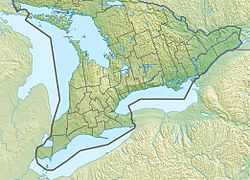York, Upper Canada
| York, Upper Canada | |
|---|---|
| Unincorporated Municipality | |

View of York from the harbour looking north, in 1803
|
|
| Nickname(s): Muddy York | |
| Location in present-day Southern Ontario | |
| Coordinates: 43°39′09″N 79°22′54″W / 43.65250°N 79.38167°WCoordinates: 43°39′09″N 79°22′54″W / 43.65250°N 79.38167°W | |
| Country | British North America |
| Colony | Upper Canada |
| Town | York |
| Established | 1793 |
| Government | |
| • Governing Body | Upper Canada |
The Town of York was the second capital of the district of Upper Canada and the predecessor to Toronto (1834). It was established in 1793 by Lieutenant-Governor John Graves Simcoe as a "temporary" location for the capital of Upper Canada, while he made plans to build a capital near today's London, Ontario. Simcoe renamed the location York after Prince Frederick, Duke of York and Albany, George III's second son. Simcoe gave up his plan to build a capital at London, and York became the permanent capital of Upper Canada on February 1, 1796. That year Simcoe returned to Britain and was temporarily replaced by Peter Russell.
The original townsite was a compact ten blocks near the mouth of the Don River and a garrison was built at the channel to Toronto Harbour. Government buildings and a law court were established. Yonge Street was built, connecting York to the Holland River to the north. To the east, Kingston Road was built to the mouth of the Trent River. In 1797, the town site was expanded to the west to allow for public buildings and expansion. One of the new area's public functions, a public market, was started in 1803. It continues today as St. Lawrence Market.
The garrison was attacked during the War of 1812. As the British Army retreated, it blew up the garrison, leading to the death of numerous American soldiers and the American general commanding the attack. The victorious Americans sacked the town and burned down the government buildings. The Americans chose not to occupy the town and the British eventually returned without conflict. A retribution attack was made on the American capital of Washington.
...
Wikipedia

